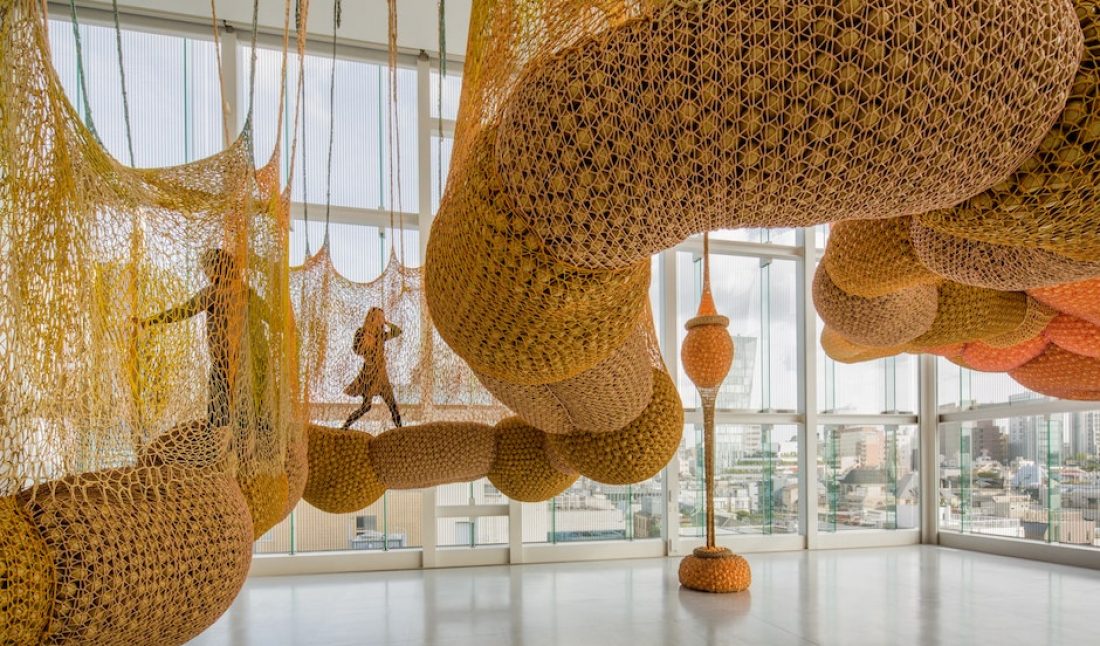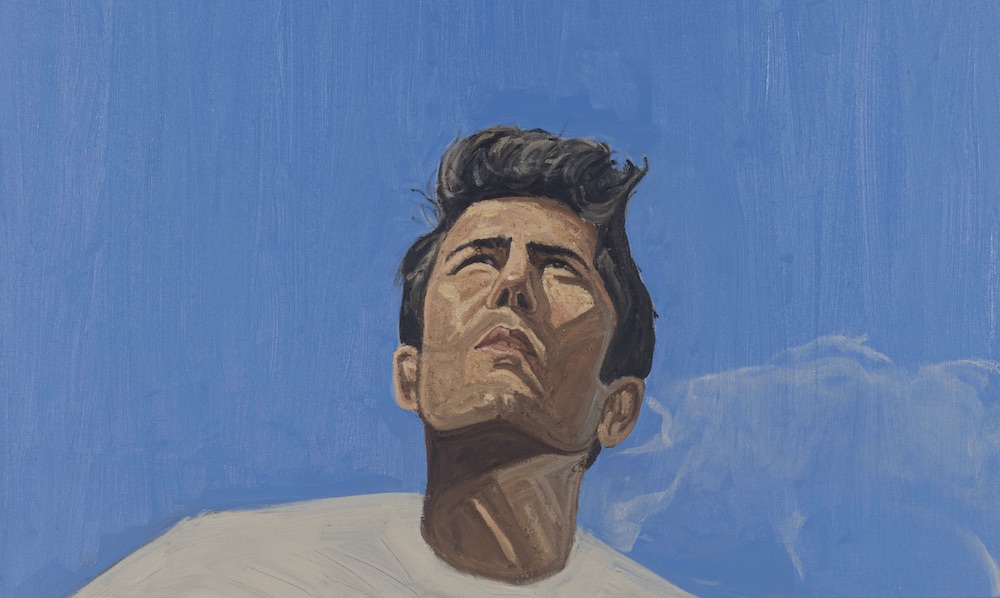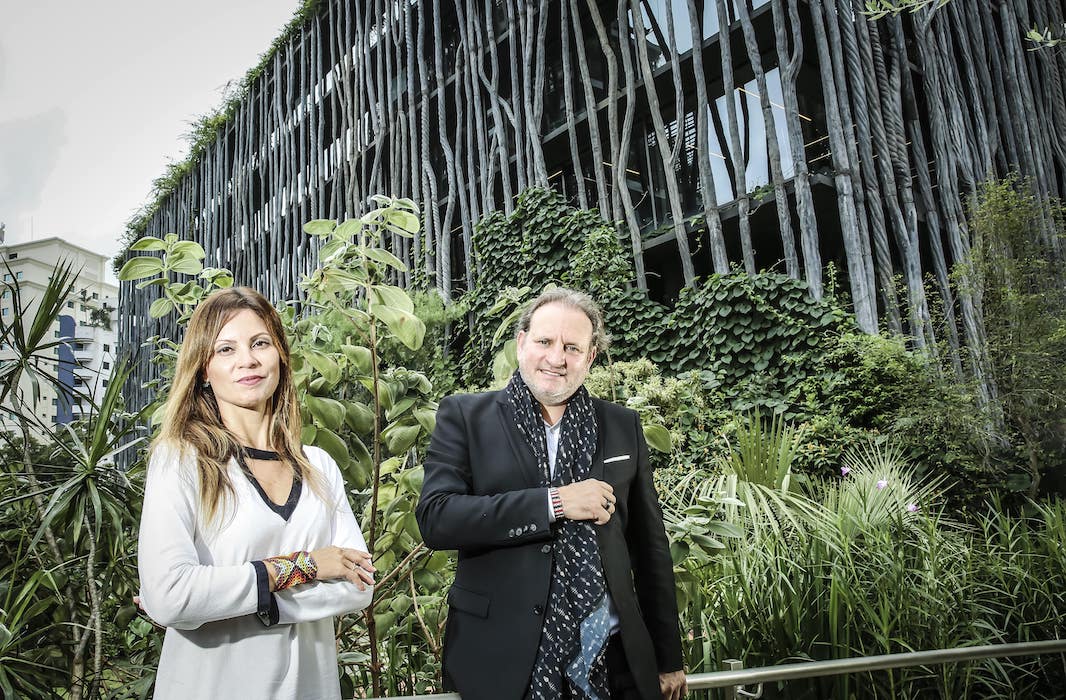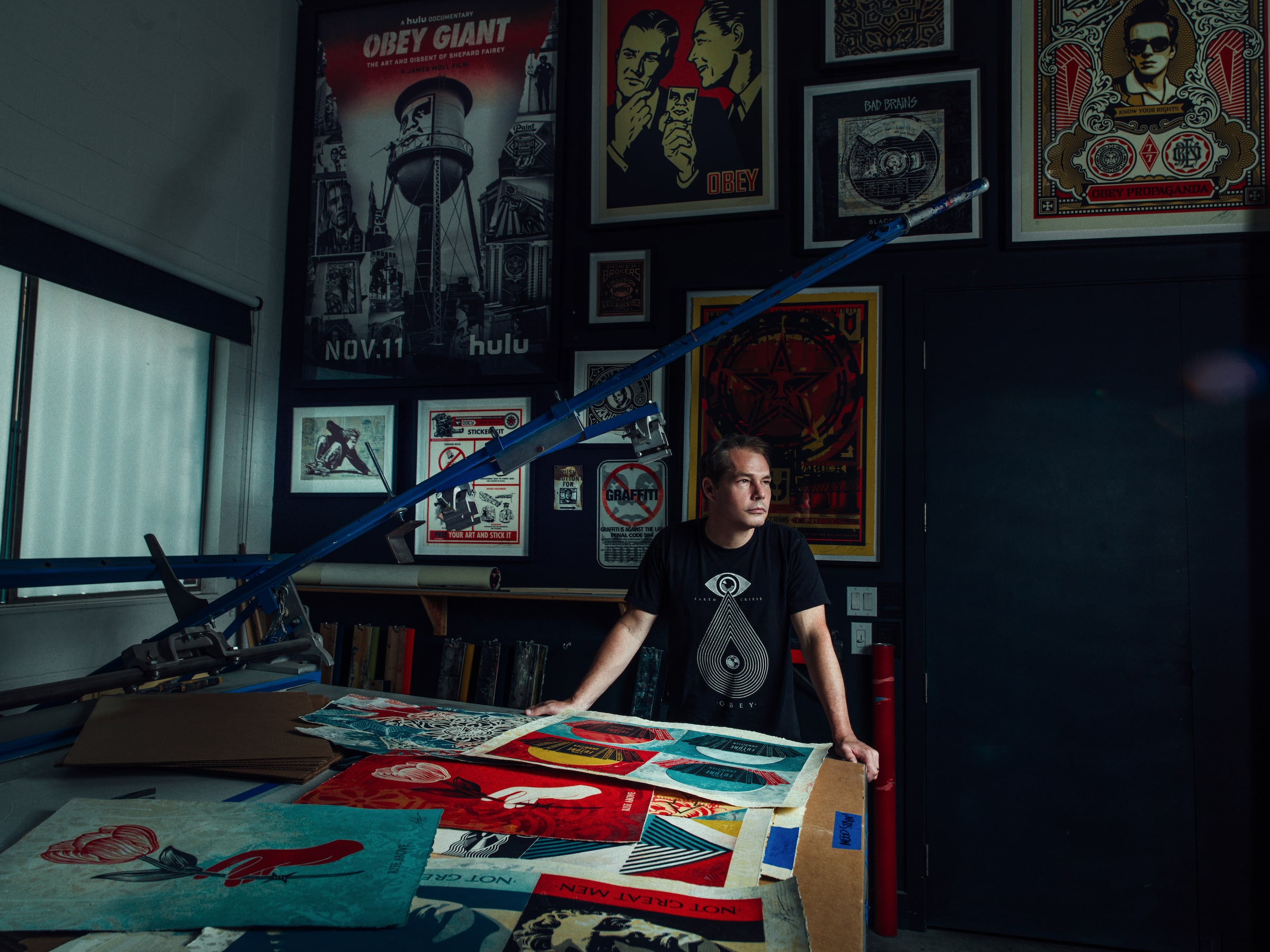Joy, Tenderness, and a Return to Nature
The Brazilian artist Ernesto Neto is known for his transcendental creative process, which marries the physical and spiritual worlds. Globally, he has presented large-scale immersive environments to solicit viewer participation, encouraging guests to see, feel, and travel through things that may otherwise be imagined. Toying with the use of multisensory elements—including fragrance and sound, as well as scale and texture—his experiential atmospheres are often filled with soft, biomorphic sculptures, scents, and audio to explore the idea of nature’s power and self’s awareness. Created collaboratively with craft communities, and even Indigenous people, his works have evolved from featuring off-white sculptures to colorful, crocheted atmospheres.
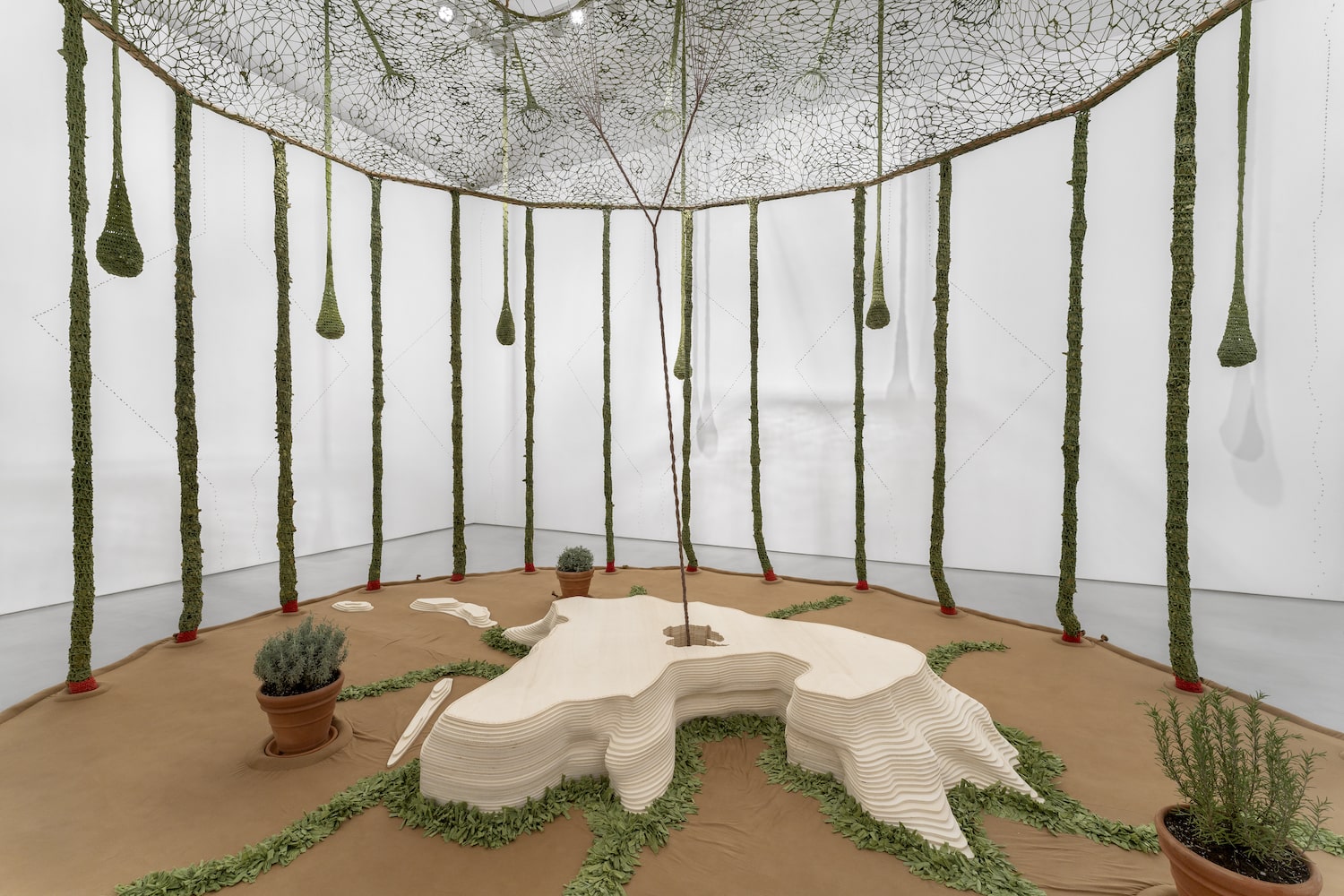 Installation view of “Ultimatum” by Ernesto Neto at Galerie Max Hetzler, 2022, photo by Nicolas Brasseur, © Studio Ernesto Neto.
Installation view of “Ultimatum” by Ernesto Neto at Galerie Max Hetzler, 2022, photo by Nicolas Brasseur, © Studio Ernesto Neto.
Last year, his solo exhibition “Ultimatum” (March 12–April 16, 2022) at Galerie Max Hetzler in Paris invited viewers to consider the time we have left to reduce our use of the planet’s resources. Aimed at reconnecting viewers with nature, and in turn themselves, the holistic installation featured a metaphorical tree trunk that you could enter, with a green webbed top and drooping spheres reminiscent of branches, as well as a ceremonial song murmuring in the background. Drawings of soybeans appeared on dark backgrounds that evoked the color of oil, reminding us of what is naturally found and unnaturally mined in the environment.
Neto’s exhibition “Between Earth and Sky” (May 14–June 16, 2022) filled several rooms at Tanya Bonakdar Gallery in New York with sculptures that represented the cycle of nature. Continuing to explore his idea that humans and the environment are inseparable systems, the show included formations evoking earth, the ocean, trees, and the sky. Guests were invited to take off their shoes, lie down, and contemplate their connection to the natural world.
Over the past three decades, all of his works have explored urgent topics tied to nature, revealing the previously unseen in meaningful and meditative ways. Ahead of presenting an exhibition with the Museum of Art, Architecture and Technology in Lisbon, Neto spoke with Whitewall about why his atmospheric works represent humankind’s relationship with nature, which materials are used as metaphors, and how his surroundings in Rio de Janeiro guide the light.
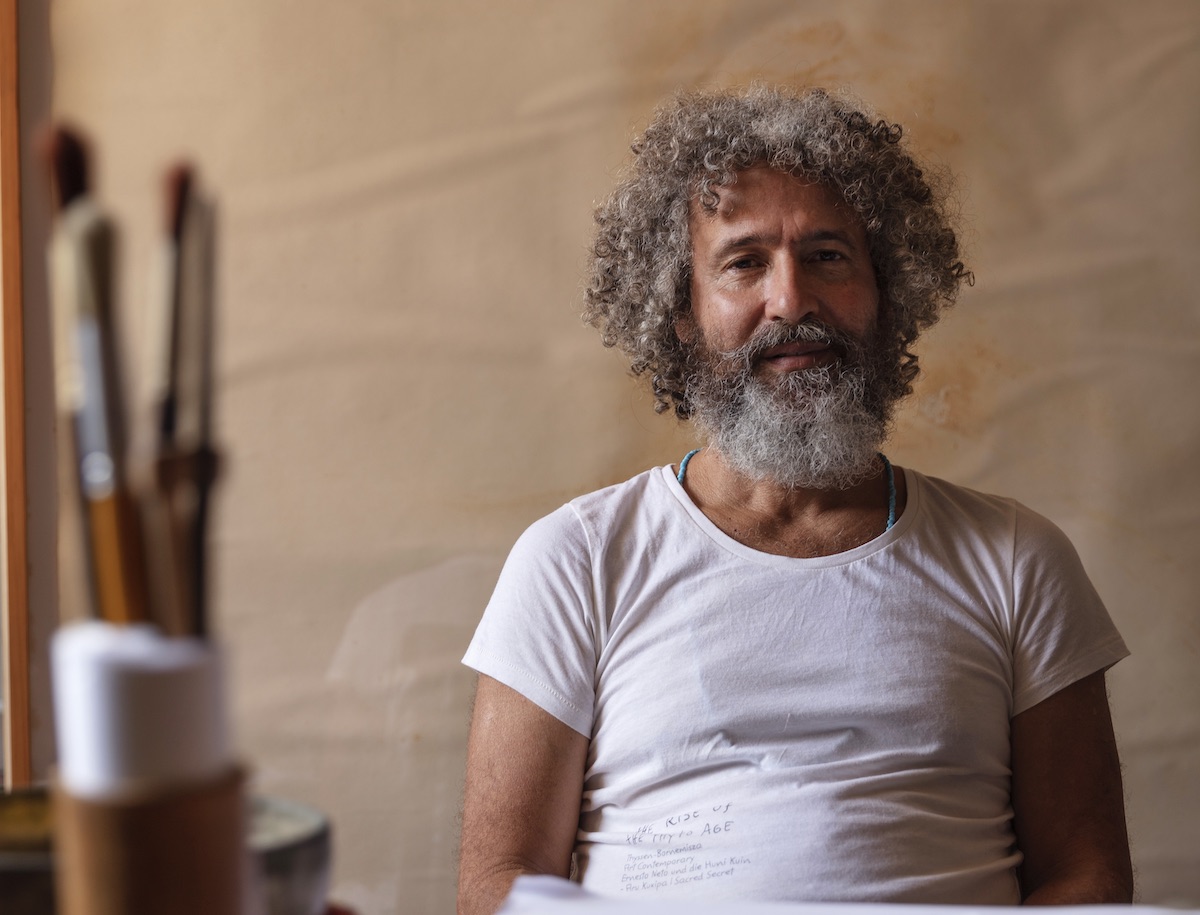 Portrait of Ernesto Neto by Paulo Schettino, courtesy of Studio Ernesto Neto.
Portrait of Ernesto Neto by Paulo Schettino, courtesy of Studio Ernesto Neto.
“Joy is the grace of being alive.”
WHITEWALL: You’ve previously said, “I understand the world as a sculpture.” Did growing up with a mother who was a landscape artist impact your concept of sculptural landscapes?
ERNESTO NETO: Yes, no doubt. With my mother, I got close to plants—to the life of it. Everything is a sculpture. But in Rio de Janeiro, landscape nature is very strong. There is this absurd relationship between nature and civilization, house and garden, walls and plants. Rio de Janeiro has the eternity of the mountains and the infinity of the sea. Between that, there is the light of the forest, the Atlantic forest, where symbiosis is the music. Everything is in a relationship.
WW: In your early works, you worked with off-white materials and gradually embraced color and more handmade work like crochet. What did this new dimension bring to your work?
EN: The handwork and the color brought more joy, more energy, more vibration, and more serenity. In 1994, I was already working with textiles, but with less intensity than I was later, and I decided to learn how to make a textile. I asked my grandmother how to make a textile, how to crochet. Many years later I had problems that I needed to solve as sculpture, and I went back to doing crochet. I fell in love with that, and it opened a huge door to the topological process of how to make a sculpture in a body context, as I have been doing since the beginning.
WW: Can tell us about working in crochet?
EN: We do finger crochet, and have a group of people that know how to do that. We have taught people how to do this finger crochet around many countries, and it is collective. The crochet we do is made of cells, so first we produce a lot of cells that people can do in their homes. Then we connect them at the studio, and fill the empty spaces between them. It is the negative crochet. The cells are made from inside to outside, and the filling is made from the outside to the inside. So, two spirals vibrating over the skin of the art—in out, in out, in out.
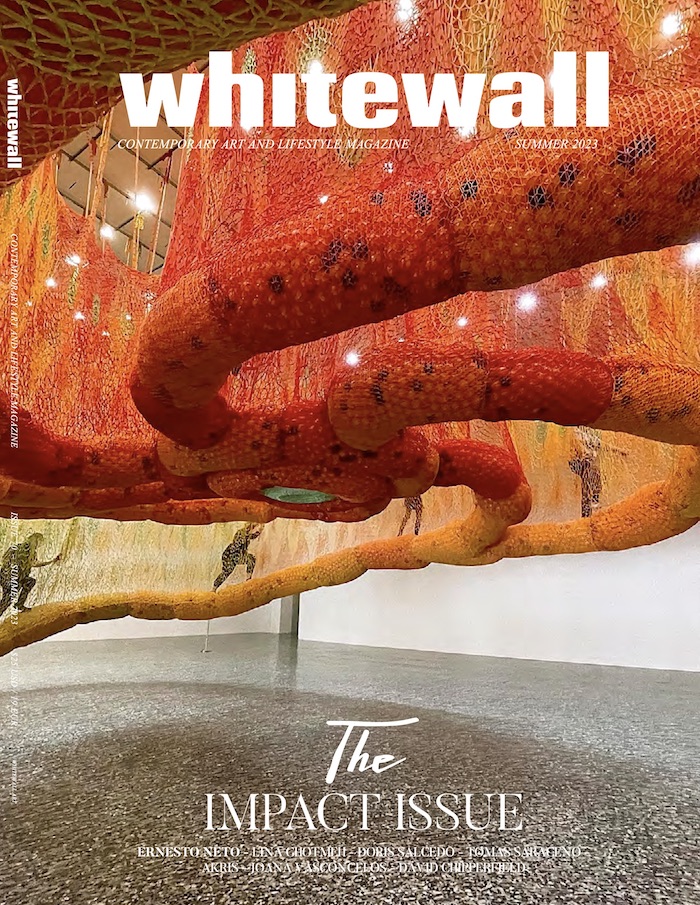 Ernesto Neto, installation view, “SunForceOceanLife,” 2020, crocheted textile and plastic balls, the Museum of Fine Arts, Houston, museum purchase funded by the Caroline Wiess Law Accessions Endowment Fund; © 2020 Ernesto Neto, photo by Albert Sanchez, courtesy of the artist, Tanya Bonakdar Gallery, New York / Los Angeles and Fortes D’Aloia & Gabriel Galeria, São Paulo and Rio de Janeiro.
Ernesto Neto, installation view, “SunForceOceanLife,” 2020, crocheted textile and plastic balls, the Museum of Fine Arts, Houston, museum purchase funded by the Caroline Wiess Law Accessions Endowment Fund; © 2020 Ernesto Neto, photo by Albert Sanchez, courtesy of the artist, Tanya Bonakdar Gallery, New York / Los Angeles and Fortes D’Aloia & Gabriel Galeria, São Paulo and Rio de Janeiro.
WW: Your work—like in “Between Earth and Sky”—offers something for all five senses. What types of materials do you like to work with to create a multisensory experience? Are the materials metaphorical?
EN: Material is always metaphorical. Every material that we touch has a force, a memory that happened between us and the materials. If you work with a thin cotton fabric that we call voile, we blow one spirit. If you work with cotton textile, we blow a different spirit, a different temperature. If you make a work, people are going to get engaged in a level of touch. Depending on the materiality you offer, you’re going to touch different levels of emotion and sensitivity of the person, and this will also generate a different reaction of the person to the artwork and from the artwork to the interior of the person. So when we say metaphor, we represent things of the memory of that person, but we also touch invisible feelings that are of this person.
WW: You’ve said that “the most important thing is the joy; we live for the joy.” How do you cultivate joy in your work? Does it happen in the making of the work?
EN: Joy is the grace of being alive, which is something that we do not value enough. In society we valorize productivity, how much money you make, and your level of success in this competitive world. It can produce a lot of pleasure and pain. Joy is something else. Joy is how given you are when you are doing something. Joy is to fill your existence between the earth and the sky, and with your arms and hearts, open to the sides to the atmosphere. Being in a state of joy is not something that we can get 24 hours a day, but if we live with this possibility and with the freedom that we are allowed to receive this grace, it moves us to an ideal situation that is not so far away from our daily life, because it is not outside of us, it is inside of us. The idea that a sculpture is happening in a state of balance and suspension transpires this energy—the energy of joy, to be here now.
WW: For sculptures like this one and others, you’ve said you “work with gravity.” What role does gravity play in your work? How do you visually represent it?
EN: Gravity is a goddess. It’s a grandfather; it’s a grandmother. It’s the energy of life. It’s our secure rope, the father and mother of everything. Gravity is a great sculpture. It’s the divine. It is infinity; it is the presence. It is the most visible of the invisible. We can’t see it, but we see its manifestation everywhere.
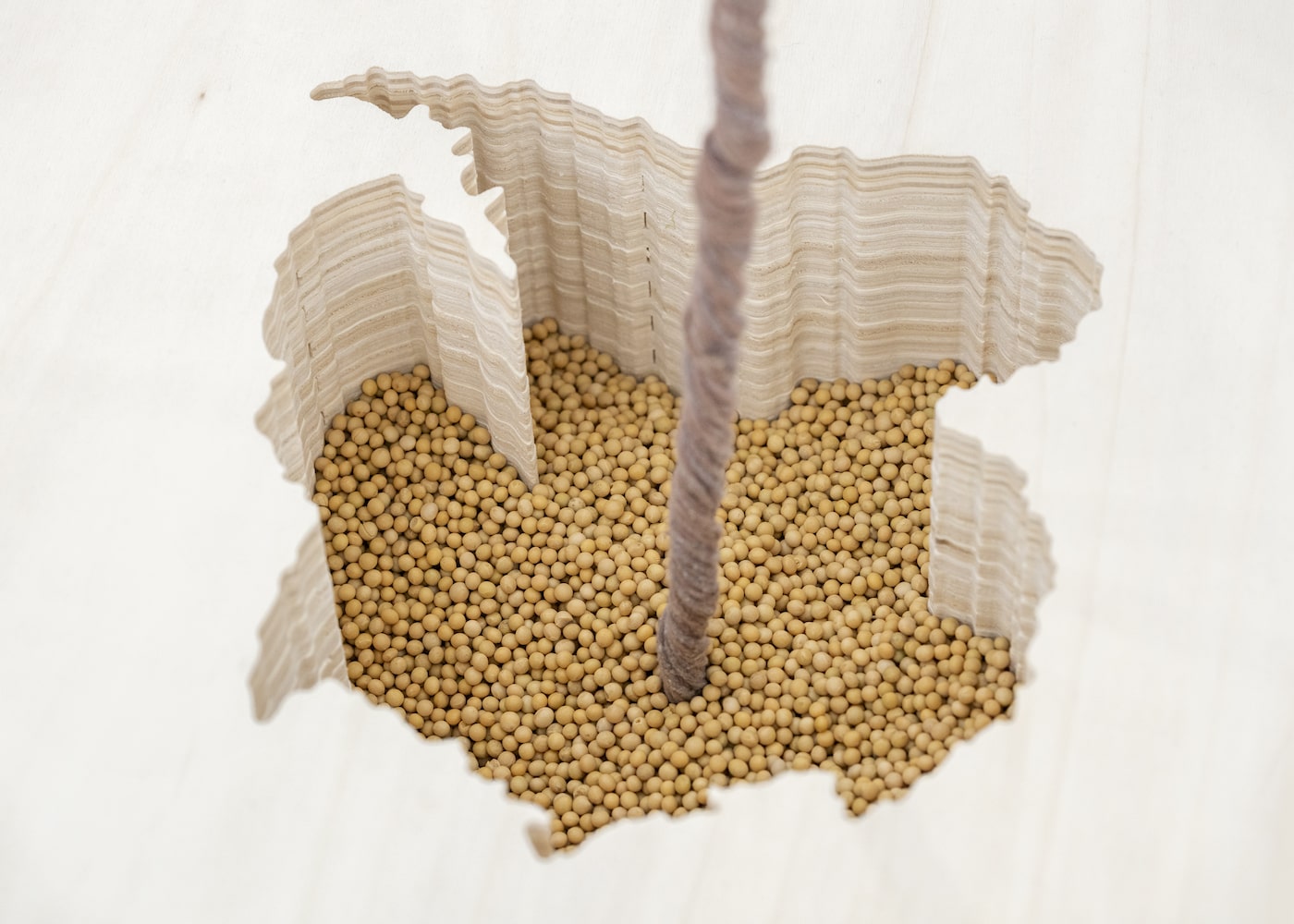 Installation view of “Ultimatum” by Ernesto Neto at Galerie Max Hetzler, 2022, photo by Nicolas Brasseur, © Studio Ernesto Neto.
Installation view of “Ultimatum” by Ernesto Neto at Galerie Max Hetzler, 2022, photo by Nicolas Brasseur, © Studio Ernesto Neto.
WW: In your recent exhibition “Ultimatum,” you communicated an urgency around climate change, stemming from the devastation in the Amazon rainforest. While your work has always dealt with humans’ relationship to nature, have you felt a growing sense of urgency in this work more recently?
EN: Yes. It is good to remember that nature is not outside of us, but it is inside of us. We are nature. The devastation that’s going on in Brazil is gigantic. This exhibition was a scream asking for help, because the consuming of this devastation is international. The commodities that are produced and taken from Brazil are for exportation—like the Brazilian wood pau brasil five hundred years ago.
We finally got rid of the ex-president. Now we have Luiz Inácio Lula da Silva, with an incredible multicultural and multinatural eco-social proposal, and we hope we are going to be able to, little by little, stop deforestation here. But as we all know, it is a worldwide problem. Global warming is arriving, and we don’t see enough answers from the capitalist society.
WW: You described the work in “Ultimatum” as new offerings for conscience and time. How do you see your work as an offering?
EN: When we put something on a stage, on a hill, or on the ground, we are offering it, in a way, to something bigger than us. When we put artwork in a gallery, in a museum, or in any art institution, we are offering it at least to the art scene. In my studio, I personally feel like talking to the infinite. I am creating artwork to the viewer, or to the art scene, in a way, but to something bigger than that. The idea of offering is an interesting point that I would like to bring to the art scene—the idea that every artwork is an offering.
WW: You have collaborated with Indigenous groups in the past, like the Huni Kuin. How has that impacted your practice?
EN: Deeply. When I met them, I had a feeling that I finally found the philosophers that I was looking for. They and I understand that most Indigenous people have a complete connection between culture and nature. There is no separation—everything is integrated. Knowledge and
spirituality walk together, and art is the mediator. There is an encounter between the spirit of art and the spirit of science. It is more than an encounter because there is no separation. Everything is one. They are all artists. And in the art, they find their living; there is art hunting, there is art fishing, there is art planting, there is art healing, there is art teaching. Everything is surrounded by singing, dancing, and painting. It brought to me more confidence and the desire to show what I was living as I always try to do with my art.
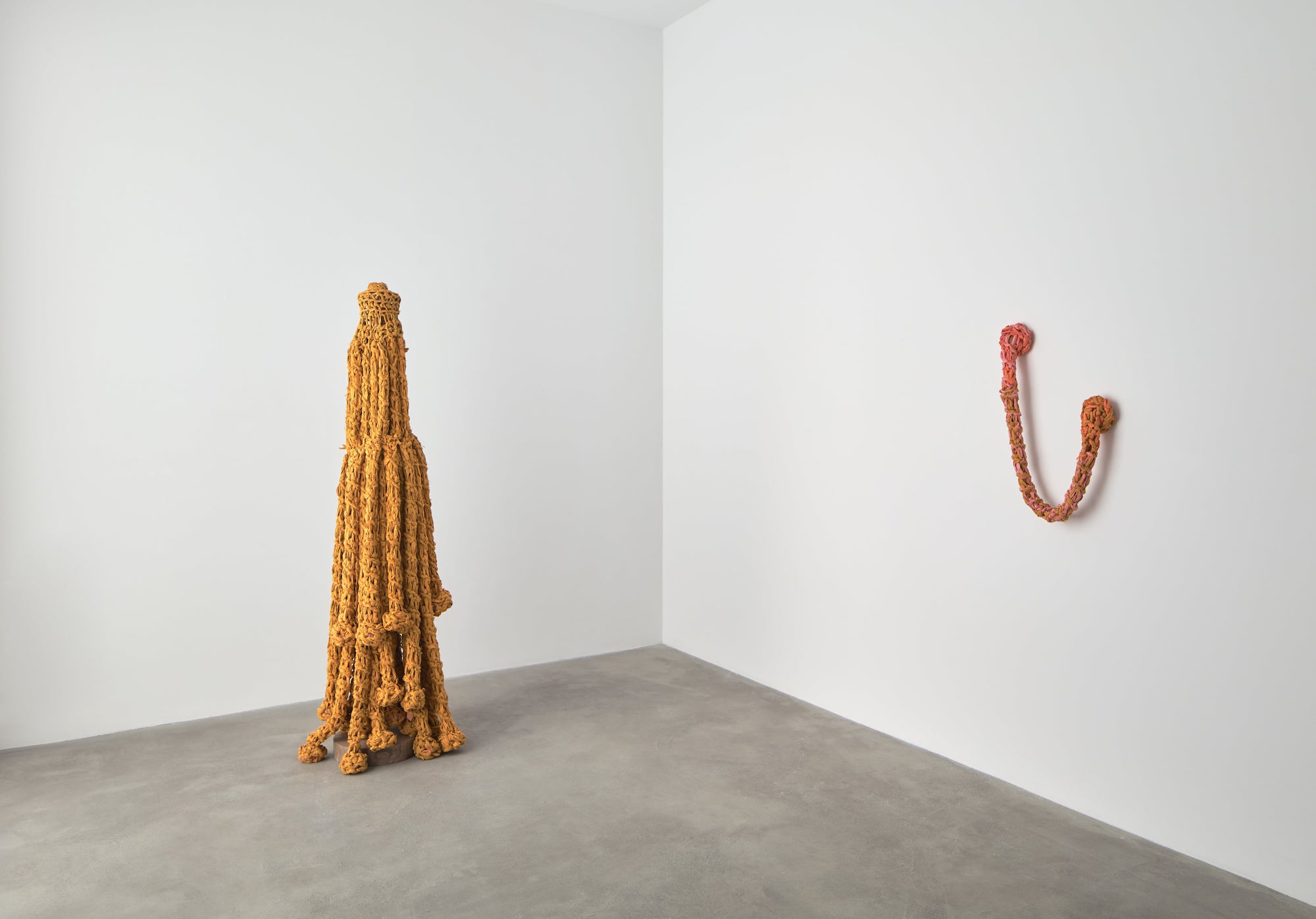 Installation view of “Children of the Earth” at Tanya Bonakdar Gallery, Los Angeles, 2019, photo by Flying Studio, courtesy of the artist and Tanya Bonakdar Gallery, New York / Los Angeles.
Installation view of “Children of the Earth” at Tanya Bonakdar Gallery, Los Angeles, 2019, photo by Flying Studio, courtesy of the artist and Tanya Bonakdar Gallery, New York / Los Angeles.
WW: You’ve spoken about the relationship between the artist and the audience, comparing it to a spiritual connection wherein the artist forms a connection from “the subjective dimension to the landscape of social life” and that “the art is in the middle of it.” Can you describe the “middle,” where the art is?
EN: Art is not at the art object or at the human being. Art is in between; the art is the mediation. It is a force that is beyond the logos. Life is a force, energy. The same is spirituality. It is something that is in between, the ground and the sky, the body and the mind. It is the mediator. It is the unexplainable power that puts everything together. Perhaps, if we think about Paramahansa Yogananda and his tradition, it is love. If you think about the quantum mechanic, the sub-particles and all its elements, what puts them together, the energy that puts everything together, it would be this mystery—this love that is in between of everything.
WW: You’ve said, “The art is here to heal, to make us more tender to each other.” How are you creating art with healing and tenderness in mind?
EN: With my fingers. If you work with your fingers, you will feel the body of it, the tenderness of it, and the force of it. The fingers are very intelligent people who teach us when we begin to work with them. When we concentrate on the artwork, we concentrate on the essence. We do not think about the art criticism, the art environment, the art game. We are into the art element. And the art element begins to guide us, when we are in the state of art being guide of the art elements, we are flowing this energy, this tenderness. This tenderness is not so soft all the time. This tenderness can put us against the wall, but this tenderness is matriarchal. We live in this patriarchal world that is very hard, very brutal, very punitive. The earth is already balancing the matriarchal time—to the female time that we are arriving. This tenderness comes from this force. It calls your attention, it calls your responsibility, but with tenderness welcoming us to a new time.
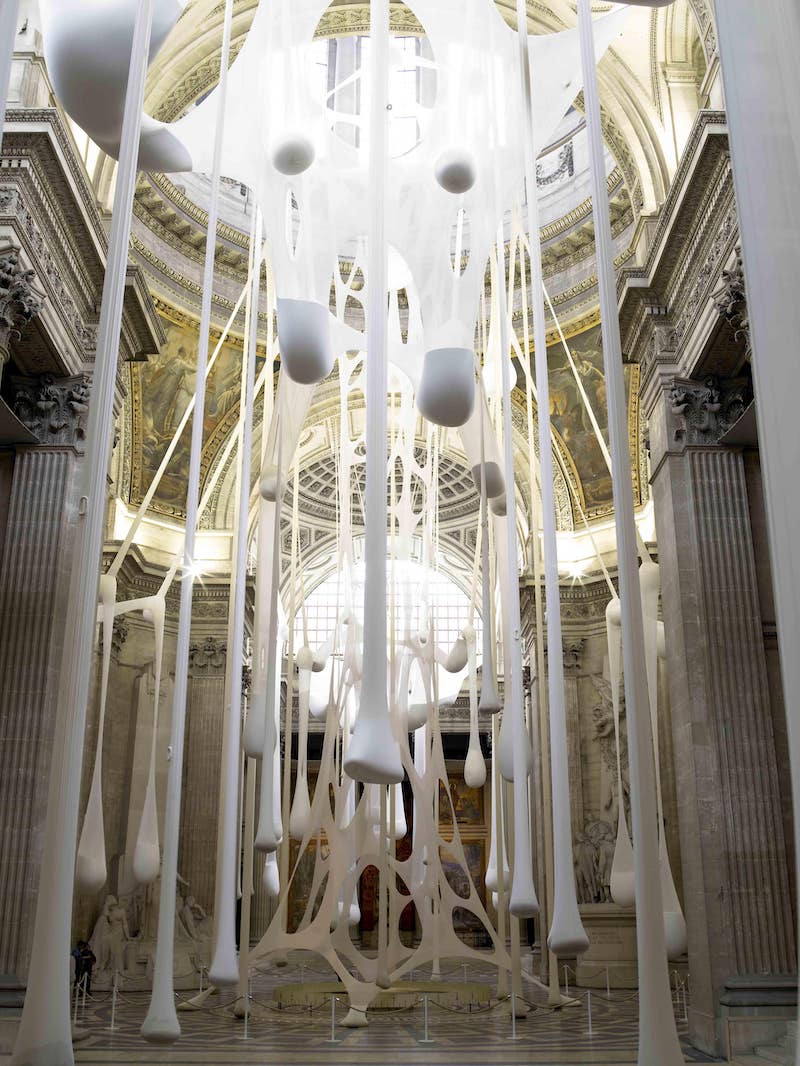 Installation view of “Leviathan Thot,” Le Festival d’Automne: Pantheon, Paris, 2006, Lycra tulle, polyamide fabric, styrofoam balls, photo by Marcus Wagner, courtesy of the artist, Tanya Bonakdar Gallery, New York / Los Angeles and Fortes D’Aloia & Gabriel Galeria, São Paulo and Rio de Janeiro.
Installation view of “Leviathan Thot,” Le Festival d’Automne: Pantheon, Paris, 2006, Lycra tulle, polyamide fabric, styrofoam balls, photo by Marcus Wagner, courtesy of the artist, Tanya Bonakdar Gallery, New York / Los Angeles and Fortes D’Aloia & Gabriel Galeria, São Paulo and Rio de Janeiro.






